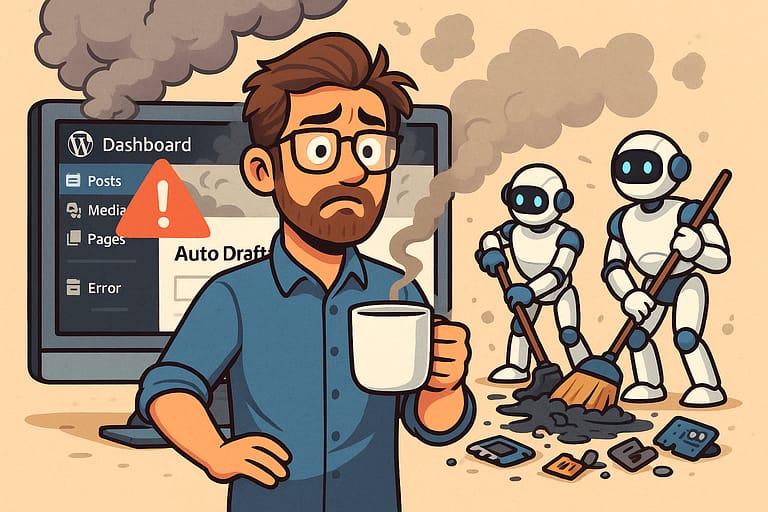
When AI Purges the Devs’ Mess
When AI Purges the Devs’ Mess. The Emergency Blogging Survival Guide
A witty, slightly chaotic, and entirely too-real guide to survive the next digital meltdown 👇
🤖 When AI Purges the Devs’ Mess
The Emergency Blogging Survival Guide (for those who dare to hit “Update”)
You were just trying to write a blog. A harmless, innocent post about life, hope, or soup recipes.
Then — BAM! — WordPress screamed:
“Database error.”
“Auto Draft created.”
“Your text has been vaporized. Have a nice day.” 💥
And just like that, AI decided to purge the devs’ mess… and your masterpiece went down with it.
But fear not, brave blogger. Here’s your survival kit. 🧰
🧠 Step 1 >>> Accept That It’s Not You
Repeat after me:
“I am not the problem. The code is.”
You did not break WordPress.
You did not anger the blogging gods.
You merely stumbled into the interdimensional glitch between autosave, cache, and caffeine.
☕ Step 2>>> Brew Coffee Before Panic
Before you delete your entire site in despair, step away.
Make coffee. Tea. Hot chocolate.
Anything that lets your server cool down while you reboot your faith in humanity.
💾 Step 3 >>> Copy Before You Click
WordPress buttons lie.
They say Save but mean Erase.
They whisper Update but summon Auto Draft.
Before hitting any of them, Ctrl + A → Ctrl + C like your digital life depends on it — because it does.
🧙 Step 4 >>> Clear Cache Like a Cleric
Enter your host panel.
Click “Clear Cache” with ritualistic flair.
Whisper a blessing over your broadband:
“Begone, stale data! Thou shalt not overwrite my text again!”
(It may not help, but it feels powerful.)
🧰 Step 5 >>> Don’t Delete the Theme, Karen
It’s not your theme’s fault.
It’s not your SEO plugin’s fault.
It’s not even Elementor’s fault (okay, maybe a little).
Deleting everything only feeds the ghost.
🧘♀️ Step 6 >>> Trust the Process (and the Debug Log)
Enable debug mode.
Read the hieroglyphs in /wp-content/debug.log.
Pretend you understand them.
Then copy them into the Hostinger chat and say confidently:
“Looks like a ModSecurity rule 200003 REST API block again.”
They’ll fix it. You’ll sound like a pro. 😎
🕯 Step 7 >>> Light a Candle for the Devs
Somewhere, a developer is frantically rewriting a patch.
They haven’t slept in 36 hours.
Their code comments are now emotional support notes.
“Please work, please work, please…”
Light a candle. They’re doing their best. 🕯❤️
🪶 Step 8 >>> Blog About It
Because if you can’t fix it… make content out of it!
Call it “My Blog Was Eaten by Auto Draft: A Love Story.”
Or “When AI Tried to Save Me from Myself.”
Humor heals, and SEO loves a good tragedy.
💫 Final Blessing
“May your cache be clean,
your drafts be saved,
your sessions stay logged,
and your database never again say ‘no.’”
Be it so, and publish responsibly.
Have you met the AUTODRAFT ghost?
🛰️ Signal from the Glitch
(a transmission intercepted mid-Auto-Draft)
We interrupt your regularly scheduled inspiration
to bring you breaking nothingness.
Your post was not deleted.
It simply ascended
into draft dimension 3.0 —
where lost ideas sip espresso
and gossip about humans who overuse the Save button. ☕👻
Somewhere between cache and consciousness,
the server hiccupped,
and a whisper slipped through the static:
“Maybe… don’t post that yet.”
Across the planet, writers froze.
Screens flickered.
Plugins panicked.
Devs blamed each other in five different time zones.
Meanwhile, in the cloud’s quiet corner,
Auto Draft lit a cigarette made of code
and muttered,
“Relax, I’m just editing the timeline.” 💨
So if your words disappear tonight —
don’t curse the glitch.
It might just be saving you
from publishing a half-baked prophecy,
or another blog titled ‘Hello World (Again)’.
Breathe. Copy. Paste. Laugh.
The universe has backups.
And when the signal returns,
write like it never left. 🪶💻
Here’s the clear breakdown (no tech jargon, promise):
⚙️ The Problem Is Server-Side — Not You
When your blog fails to save or shows “database error” / “Auto Draft,”
it’s almost always happening on the server, not inside your WordPress dashboard.
That means:
- Your browser and plugins → are just the messengers.
- The server → is the one actually storing, saving, or blocking the post.
If the server:
- times out ⏳
- blocks a REST API request 🚫
- corrupts a database table 💣
- or gets too aggressive with cache 🧊
…then your post never makes it to the database — no matter how perfectly your editor works.
🧭 Translation:
You didn’t break your site.
You didn’t misclick.
You didn’t anger the blogging gods.
👉 The issue lives in the host’s back-end setup — often ModSecurity, LiteSpeed cache, or MySQL hiccups.
💡 Why That Matters
Because you can stop exhausting yourself reinstalling plugins or deleting themes (that part is safe and innocent).
The fix comes from your host’s server team, not your dashboard.
So yes — the glitch is in the grid. 🌐
Or, as we now like to say:
“The Auto Draft Ghost lives server-side.” 👻💻
30-second REST check (no plugins needed)
here’s a super-quick, no-nonsense test to prove it’s server-side. Do any ONE of these.
A) Browser check (easiest)
- Open a new tab and go to:
https://YOURDOMAIN.com/wp-json
- What you should see: a small JSON blob (site name/description).
- If you get Forbidden/401/500/timeout/blank → server is blocking REST API → server-side issue.
- If it loads fine → continue to B.
B) Post endpoint check
- While logged into WP, open:
https://YOURDOMAIN.com/wp-json/wp/v2/types/post
- Expected: a JSON object with “rest_base”: “posts”.
- If error/forbidden here → server-side block (ModSecurity, cache, or auth cookie issue).
C) Live save simulation (no code editor required)
- Open your browser console (Desktop: right-click → Inspect → Console).
- Paste this (change the post ID to a real post you can edit, e.g., 123):
fetch(‘/wp-json/wp/v2/posts/123’, {
method: ‘GET’,
credentials: ‘include’
}).then(r=>r.status).then(console.log).catch(console.error);
- If you’re logged in and get 200 → endpoint reachable.
- If 401/403/500 → server-side (auth/caching/firewall).
- Now a tiny update test (only if 2 gave 200). Replace 123 and “Test”:
fetch(‘/wp-json/wp/v2/posts/123’, {
method: ‘POST’,
credentials: ‘include’,
headers: {‘Content-Type’:’application/json’},
body: JSON.stringify({ title: ‘Test ‘ + Date.now() })
}).then(r=>r.status).then(console.log).catch(console.error);
- 201/200 = saved OK.
- 401/403/500/520 = server stopping writes → server-side(ModSecurity/DB/cache).
D) WordPress Site Health
WP Admin → Tools → Site Health → Status.
- Look for REST API or Loopback request errors.
- If flagged → copy message → that’s your proof for host support.
Quick reads of the results
- /wp-json/ fails → Firewall/ModSecurity or host cache.
- types/post fails but /wp-json/ OK → Auth/cookie blocked by cache/firewall.
- POST to /wp/v2/posts/<id> fails → ModSecurity rule (often 200003), or DB write issue.
- Sometimes only long posts fail → WAF payload size / MySQL strict mode / postmeta too large.
What to tell support (copy/paste)
Our REST API tests show /wp-json/wp/v2/posts/<id> is failing with status <PUT_STATUS_HERE>.
Please whitelist/adjust ModSecurity (rule 200003) and bypass LiteSpeed cache for /wp-json/ endpoints.
Also verify DB tables (wp_posts, wp_postmeta) and user privileges (INSERT, UPDATE).
Issue is server-side; dashboard actions reproduce consistently.
Why it hits some sites… and only sometimes
- Per-site cache/WAF rules
Hosts (WA, Hostinger) apply LiteSpeed/ModSecurity per domain. One site might be whitelisted or on a different cluster; another isn’t. So Site A saves fine, Site B gets blocked. - Content-dependent blocking
If the title saves but body doesn’t, that screams WAF payload filter:
- short/clean content → passes
- long HTML, embeds, code blocks, certain keywords/links → blocked
That’s why it feels random: it depends on that post’s content length/pattern.
- Plugin mix differs per site
Different versions/settings (SEO, page builders, multilingual, security) = different REST calls or payload sizes → only some sites trip the rule. - Table health / indexes differ
If wp_posts or wp_postmeta is slightly corrupted on one DB, only that site fails updates.
Is DST / wintertime the culprit?
Short answer: almost certainly no.
WordPress nonces are time-based but use server time in ~12-hour “ticks” and are typically UTC-aligned. The EU DST switch shouldn’t break saves. You might see oddities with scheduled posts/cron times around the change, but not selective “title only” saves or DB errors.
When DST could matter (rare):
- If server time is misconfigured (PHP timezone wrong), nonces could expire “early.” You’d see rest_cookie_invalid_nonce(403) in the Network tab.
- Fix: ensure Settings → General → Timezone matches your city and server uses UTC internally.
60-second checks to confirm
- Network tab check (when you click Update):
- If /wp-json/wp/v2/posts/<ID> returns 403 with rest_forbidden, rest_cookie_invalid_nonce, or similar → WAF/auth problem.
- If 500/520 → server/WAF/DB issue.
- If 200/201 but the editor still errors → front-end conflict.
- Change the content length:
Try saving with just “Hello” → if it saves, then paste your full text → if it fails, that’s payload size/filter. - Bypass cache once:
Add ?nocache=1 to the post edit URL and try again. If it suddenly works → caching layer.
Ask support (per affected domain)
This only affects specific domains and certain posts. Please bypass cache and whitelist WAF/ModSecurityfor:
- /wp-json/*
- /wp-admin/*
We’re seeing blocked/failed POST to /wp-json/wp/v2/posts/<id> when content is longer/rich HTML. Likely a payload rule (often 200003). Also verify DB table health (wp_posts, wp_postmeta) and user privileges.
Quick self-fixes to try
- Temporarily deactivate LiteSpeed Cache plugin (and clear server cache).
- Exclude /wp-json/ and /wp-admin/ from any caching/security plugin.
- Test with Classic Editor to reduce REST complexity.
- In phpMyAdmin: Repair + Optimize wp_posts and wp_postmeta.
- If only long posts fail, split large blocks, remove suspicious embed/code, or save in chunks to prove the payload angle.
Ready to launch your online business the smart way?
Register your domain with Namegenuity
and connect it instantly
to Wealthy Affiliate’s powerful hosting platform.
No upsells, no tech headaches.
Just smooth, secure site setup
with everything you need in one place.
👉 Start building with Namegenuity + WA today.




